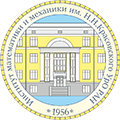REDUCING GRAPHS BY LIFTING ROTATIONS OF EDGES TO SPLITTABLE GRAPHS
Abstract
A graph \(G\) is splittable if its set of vertices can be represented as the union of a clique and a coclique. We will call a graph \(H\) a splittable ancestor of a graph \(G\) if the graph \(G\) is reducible to the graph \(H\) using some sequential lifting rotations of edges and \(H\) is a splittable graph. A splittable \(r\)-ancestor of \(G\) we will call its splittable ancestor whose Durfey rank is \(r\). Let us set \(s = ({1}/{2}) (\mathrm{sum}\,\mathrm{tl}(\lambda) - \mathrm{sum}\,\mathrm{hd}(\lambda))\), where \(\mathrm{hd}(\lambda)\) and \(\mathrm{tl}(\lambda)\) are the head and the tail of a partition \(\lambda\). The main goal of this work is to prove that any graph \(G\) of Durfey rank \(r\) is reducible by \(s\) successive lifting rotations of edges to a splittable \(r\)-ancestor \(H\) and \(s\) is the smallest non-negative integer with this property. Note that the degree partition \(\mathrm{dpt}(G)\) of the graph \(G\) can be obtained from the degree partition \(\mathrm{dpt}(H)\) of the splittable \(r\)-ancestor \(H\) using a sequence of \(s\) elementary transformations of the first type. The obtained results provide new opportunities for investigating the set of all realizations of a given graphical partition using splittable graphs.
Keywords
Full Text:
PDFReferences
- Andrews G.E. The Theory of Partitions. Cambridge: Cambridge Univ. Press, 1976. 255 p. DOI: 10.1017/CBO9780511608650
- Baransky V.A., Senchonok T.A. Around the Erdös–Gallai criterion. Ural Math. J., 2023. Vol. 9, No. 1. P. 29–48. DOI: 10.15826/umj.2023.1.003
- Foldes S., Hammer P.L. Split graphs. In: Proc. of the 8th South-Eastern Conf. on Comb.: Graph Theory and Computing, 1977. P. 311–315.
- Fulkerson D.R., Hoffman A.J., McAndrew M. H. Some properties of graphs with multiple edges. Canad. J. Math., 1965. Vol. 17. P. 166–177. DOI: 10.4153/CJM-1965-016-2
- Hammer P.L., Simeone B. The splittance of a graph. Combinatorica, 1981. Vol. 1. P. 275–284. DOI: 10.1007/BF02579333
- Mahadev N.V.R., Peled U.N. Threshold Graphs and Related Topics. Ser. Annals of Discr. Math., vol. 56. Amsterdam: North-Holland Publ. Co., 1995. 542 p.
- Merris R. Graph Theory. New York: J. Wiley & Sons Inc., 2001. 256 p. DOI: 10.1002/9781118033043
- Merris R. Split graphs. European J. Combin., 2003. Vol. 24. P. 413–430. DOI: 10.1016/S0195-6698(03)00030-1
- Tyshkevich R.I. Decomposition of graphical sequences and unigraphs. Discrete Math., 2000. Vol. 220. P. 201–238. DOI: 10.1016/S0012-365X(99)00381-7
Article Metrics
Refbacks
- There are currently no refbacks.













